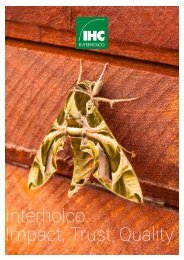Nomenclature Générale des Bois Tropicaux - 7ème édition
(english description below) Cette nomenclature est utilisée pour la mise à jour du 'Harmonized Code System' de l’Organisation Mondiale des Douanes. Dans la circulaire du 5 avril 2005, le Ministère de l’Economie, des Finances et de l’Industrie (France) reconnaît l’ATIBT comme « gardien du temple » de la nomenclature des bois tropicaux. La Commission Européenne mentionne la nomenclature de l’ATIBT comme document de référence pour la mise en œuvre du RBUE. Depuis 1954, l’ATIBT a établi et mis à jour une nomenclature des bois tropicaux faisant correspondre chaque espèce botanique avec un nom pilote reconnu internationalement. La détermination du nom pilote d’une essence est cruciale, car sa commercialisation dépend très largement de l’adoption de ce nom par le public. Le nom pilote assure la protection de l’appellation commerciale de l’essence et l’intégrité des propriétés qui lui sont attribuées, sans risque de confusion. The 1982 version of the general timber nomenclature has finally been updated as some of the 1,750 identified species, are no longer traded, while others, which were not previously included, are now on the market. The present revision has also integrated changes related to new taxonomy, in order to reflect the latest scientific developments. This Nomenclature has been used for the Harmonized Code System, updated by the World Customs Organization. The French Ministry of economy, finance and industry has given official recognition to ATIBT as the reference for the tropical timber nomenclature (NOR: PRMX0508285C of April 5th 2005). The European Commission refers to ATIBT nomenclature as a reference document for the implementation of the EUTR regulation. Since 1954, ATIBT has established and updated a nomenclature of tropical wood, linking each botanical species with an internationally recognized pilot name. A sigle wood species may have many common names; when trading across different countries, this may lead to confusion. Fixing the pilot name of a timber species is crucial, to protect the commercial denomination of the species and guarantee the veracity of the properties linked to that species, without confusion.
(english description below)
Cette nomenclature est utilisée pour la mise à jour du 'Harmonized Code System' de l’Organisation Mondiale des Douanes. Dans la circulaire du 5 avril 2005, le Ministère de l’Economie, des Finances et de l’Industrie (France) reconnaît l’ATIBT comme « gardien du temple » de la nomenclature des bois tropicaux. La Commission Européenne mentionne la nomenclature de l’ATIBT comme document de référence pour la mise en œuvre du RBUE.
Depuis 1954, l’ATIBT a établi et mis à jour une nomenclature des bois tropicaux faisant correspondre chaque espèce botanique avec un nom pilote reconnu internationalement. La détermination du nom pilote d’une essence est cruciale, car sa commercialisation dépend très largement de l’adoption de ce nom par le public. Le nom pilote assure la protection de l’appellation commerciale de l’essence et l’intégrité des propriétés qui lui sont attribuées, sans risque de confusion.
The 1982 version of the general timber nomenclature has finally been updated as some of the 1,750 identified species, are no longer traded, while others, which were not previously included, are now on the market. The present revision has also integrated changes related to new taxonomy, in order to reflect the latest scientific developments.
This Nomenclature has been used for the Harmonized Code System, updated by the World Customs Organization. The French Ministry of economy, finance and industry has given official recognition to ATIBT as the reference for the tropical timber nomenclature (NOR: PRMX0508285C of April 5th 2005). The European Commission refers to ATIBT nomenclature as a reference document for the implementation of the EUTR regulation.
Since 1954, ATIBT has established and updated a nomenclature of tropical wood, linking each botanical species with an internationally recognized pilot name. A sigle wood species may have many common names; when trading across different countries, this may lead to confusion. Fixing the pilot name of a timber species is crucial, to protect the commercial denomination of the species and guarantee the veracity of the properties linked to that species, without confusion.
Create successful ePaper yourself
Turn your PDF publications into a flip-book with our unique Google optimized e-Paper software.
Liste des noms vernaculaires avec renvoi au nom pilote /// 99
NOMS VERNA-
CULAIRES
COMMON
NAMES
PAYS
COUNTRY
Bois perdrix GF Wacapou
Bois rouge GF Umiri
NOM PILOTE
PILOT NAME
Bois serpent GF Angelim rajado
Bois tapiré GF Cedroi
Bois violet GF Pau roxo
Bokanga CD Lati
Bokapi GQ Niové
Bokoi CF Sipo
Bokoka CM Okan
Bokoli CD Oboto
Bokungu CD Dabéma
Bolé CD Mutondo
Boleka CD Kibakoko
Boleko CD Angueuk
Bolele CF Oboto
Bolengu CD Doussié
Bolengu CD Faro
Boliki CD Oboto
Bolletrie SR Maçaranduba
Bolon KE Bossé foncé
Bolunde CD Ohia
Bom Pegya GH Oboto
Bomanga CD Bomanga
Bomanga CG Bomanga
Bombax PG Kapok
Bombax GH Kondroti
Bombulu CD Dibétou
Bon CI Cordia d’Afrique
Bonde CF Difou
Bondu LR Gombé
Bonga PA Baromalli
Bonga CO Sumauna
Bongele CM Eyong
Bongo CF Eyong
Bongo CM Olon
Bongo CM Olonvogo
Bongola CD Eyoum
Bongossi CM Azobé
Bonkingu CD Bilinga
Bonkole CG Azobé
Bonkongo CD Ako
Bonkonko CD Ako
NOMS VERNA-
CULAIRES
COMMON
NAMES
PAYS
COUNTRY
Bonkotombolo CD Kibakoko
NOM PILOTE
PILOT NAME
Bonsamdua GH Movingui
Bonzale CD Kanda brun
Bonzale CF Kanda brun
Bonzale CD Kanda rose
Bopambu CD Longhi
Borracho BO Morototo
Bosasa CD Bossé clair
Bosenge CD Rikio
Boshcalabas SR Couroupita
Boshimi CD Yungu
Boshpapaja SR Imbauba
Boskasjoe SR Caju açu
Bosneak KH Penaga
Boso CM Igaganga
Bossé clair CI Bossé clair
Bosso CG Dibétou
Bossoho CD Essia
Bostamarinde SR Angelim rajado
Boto CI Pau rosa
Botoro ET Lusambya
Bouanga CF Mukulungu
Bouchi-cajou GF Caju açu
Bouemon CI Okan
Bougou Bati Batra GF Batibatra
Bougouni GF Inga
Boulet de canon GF Couroupita
Bouma CM Fuma
Bounaati GF Wacapou
Boxwood ZA Boxwood
Boyo Kondi CF Dibétou
Brasiletto BR Braziletto
Braúna BR Braúna
Brea amarilla BO Manil
Brea caspi PE Manil
Breu BR Kurokaï
Breu grande BR Amesclào
Breu manga BR Amesclào
Breu preto BR Amesclào
Breu-sucuruba BR Amesclão
Broad-Leaved GY Burada
Broutou CI Gombé














